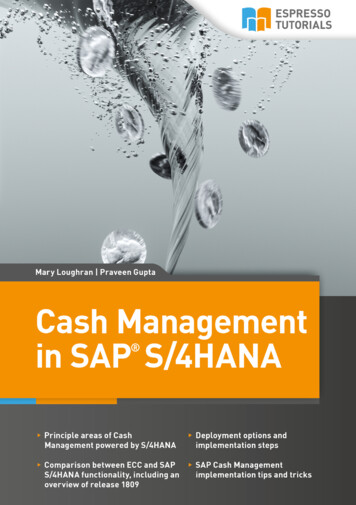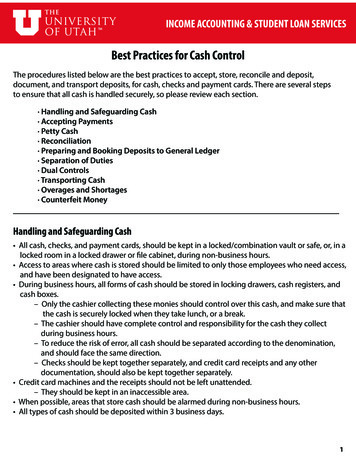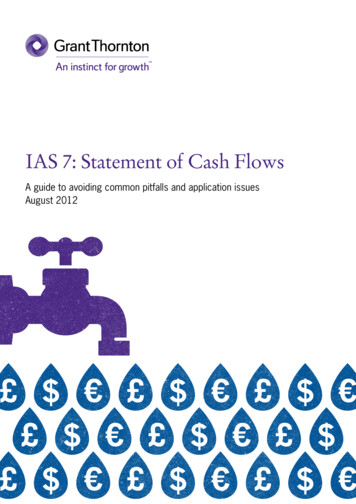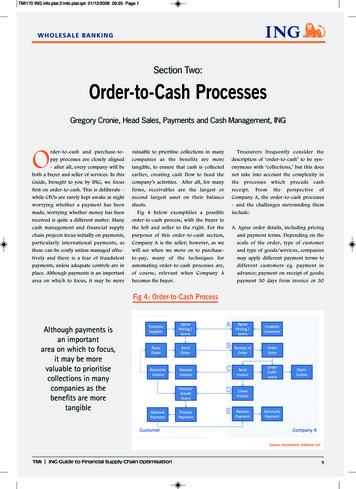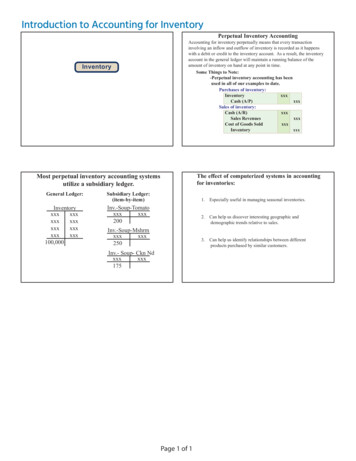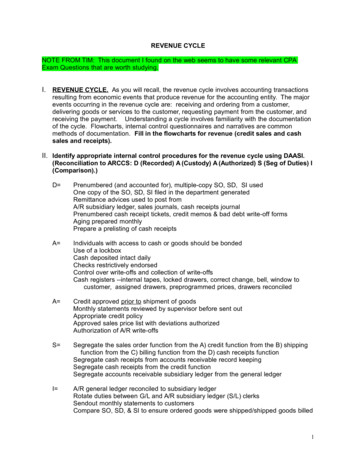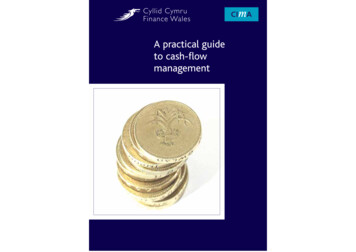
Transcription
A practical guideto cash-flowmanagement
ForewordIt is more than a business cliché to state that ‘cash is king’. However, as with all clichés,the statement is borne in fact. None more so than this, which highlights the vital importanceof cash to modern small businesses. While profit, turnover and even market share are all indicatorsof success, if there is no cash in the bank to meet monthly bills, wage runs and loan paymentsthen any business will ultimately fail.At Finance Wales we are able to provide small and medium-sized enterprises (SMEs) and socialenterprises with a range of support to assist with cash flow. From providing your business withthe right sort of financial support for asset purchase to assisting you in the developmentof your business, we can help ease the strain on your cash reserves. By choosing the right combinationof debt and equity, your business will be able to take the fullest advantage of any opportunitywithout draining the life blood of your business, its cash.We also have a wide range of business support programmes that can provide guidance on how bestto deploy your cash to its best advantage. While we cannot make decisions for you, our expertmentors and investment support team can point you in the right direction.Cash-flow management is vital to the health of your business and it is in the day-to-day managementof your business that cash is most effectively controlled. Those day-to-day decisions rest firmlywith company directors and business owners. This guide is designed to be used on an ongoing basisas a support tool for long-term planning and day-to-day reference. It explores cash managementand looks at maximising cash inflows, managing cash outflows, cash-flow budgeting and usingcompany accounts. It is not intended to be complex or exhaustive, but rather to act as a basicguide to the smaller business.To find out more about the Chartered Institute of Management Accountants, contact:Stathis Gould, Head of Technical Issues, Chartered Institute of Management Accountants,26 Chapter Street, London SW1P 4NPTel: 020 8849 2379 Email: stathis.gould@cimaglobal.com Web: www.cimaglobal.comFinance Wales is dedicated to providing financial investment and management support to newand aspiring Welsh businesses. With a range of funding and management support solutionsand with close links to business support agencies throughout Wales, we are uniquely placedto provide the right assistance at the right time.For more information on the ways in which Finance Wales can assist businesses and social enterprises,contact us on 0800 587 4140 Email: info@financewales.co.uk Web: www.financewales.co.ukIf you are a textphone user,18001 029 2033 8156., you can contact us on 18001 0800 587 4140 orSian Lloyd-JonesChief Executive of Finance WalesI am delighted that we have been given the kind permission of the Chartered Institute ofManagement Accountants (CIMA) to reproduce this guide, which is one of a series of businessguides prepared by CIMA and produced by Finance Wales. Assistance was gratefully receivedfrom Paul B. Jackson, Consultant Financial Management and Anita Allott, Research Analyst,Consensus Communications. We acknowledge CIMA’s assistance and would like to thankthem for their support.Finance Wales and CIMA champion management accountancy worldwide. In an age of growingglobalisation and intensified competition, modern businesses demand timely and accuratefinancial information. That is why high quality professional advice and support are vital to the successof 21st century businesses.From its headquarters in London and eleven offices outside the UK, CIMA supports 60,000 membersand 77,000 students in 155 countries. CIMA’s focus on management functions makes them uniquein the accountancy profession. The CIMA qualification is recognised internationally as the financialqualification for business and its reputation and value are maintained through high standardsof assessment and regulation.23
ContentsCash-flow management – the outline casePageCash-flow management – the outline case1. Cash-flow cycle Cash-flow management Cash conversion period456672. Accelerating cash inflows Customer purchase decision and ordering Credit decisions Fulfilment, shipping and handling Invoicing the customer The collection period Payment and deposit of funds The Late Payment of Commercial Debts (Interest) Act 199899913141416163. Cash-flow budget Cash inflows Cash outflows Putting the projections together171720224. Cash-flow surpluses and shortages Surpluses Sources of finance Factoring242424255. Using company accounts Current ratio Liquidity ratio or acid test or quick ratio ROCE (return on capital employed) Debt/equity (gearing) Profit/sales Debtors days sales outstanding Creditors days sales26262626272727276. Insolvency by overtrading Overtrading scenario28287. Conclusion308. Useful reading31Cash flow is generally acknowledged as the single most pressing concern of the SME(small and medium-sized enterprise). In its simplest form cash flow is the movement of moneyin and out of your business. Cash flow is the life-blood of all growing businesses and is the primaryindicator of business health. The effect of cash flow is real, immediate and, if mismanaged,totally unforgiving. Cash needs to be monitored, protected, controlled and put to work.There are four principles regarding cash management: First, cash is not given. It is not the passive, inevitable outcome of your business endeavours.It does not arrive in your bank account willingly. Rather it has to be tracked, chased and captured.You need to control the process and there is always scope for improvement Second, cash management is as much an integral part of your business cycle as, for example,making and shipping widgets or preparing and providing detailed consultancy services Third, you need information. For example, you need immediate access to information on: your customers’ credit worthiness your customers’ current track record on payments outstanding receipts your suppliers’ payment terms short-term cash demands short-term surpluses investment options current debt capacity longer-term projections Fourth, be masterfulProfessional cash management in business is not, unfortunately, always the norm. In a poll conductedon the Better Practice Payment Group website during November 2003, nearly a quarterof the respondents declared that they never confirm their credit terms in writing with customers.You will find, therefore, that the cash management process has a double benefit: it can help youto avoid the debilitating downside of cash crises and, in addition, grant you a commercial edgein all your transactions.5
1. Cash-flow cycleCash flow can be described as a cycle: your business uses cash to acquire resources.The resources are put to work and goods and services produced. These are then sold to customers,you collect and deposit the funds and so the cycle repeats. But what is crucially important is thatyou actively manage and control these cash inflows and outflows. It is the timing of these moneyflows which can be vital to the success, or otherwise, of your business.It must be emphasised that your profits are not the same as your cash flow. It is possible to projecta healthy profit for the year and yet face a significant and costly monetary squeeze at various pointsduring the year, such that you may worry whether your company can survive.InflowsInflows are the movement of money into your business. Inflows are most likely from the: receipt of monies from the sale of your goods/services to customers receipt of monies on customer accounts outstanding proceeds from a bank loan interest received on investments investment by shareholders in the companyOutflowsOutflows are the movement of money out of your business. Outflows are most likely from: purchasing finished goods for re-sale purchasing raw materials and other components needed for the manufacturing of the final product paying salaries and wages and other operating expenses purchasing fixed assets paying principal and interest on loans paying taxesCash-flow managementCash-flow management is vital to the health of your business. Hopefully, each time throughthe cycle, a little more money is put back into the business than flows out. But not necessarily,and if you don’t carefully monitor your cash flow and take corrective action when necessary,your business may find itself sinking into trouble.Cash outflows and inflows seldom seem to occur together. More often than not, cash inflowsseem to lag behind your cash outflows, leaving your business short. This money shortage is yourcash-flow gap. Managing your cash flow allows you to narrow or completely close your cash-flowgap and you do this by examining the different items that affect the cash flow of your businessas listed above.6Answer the following questions: How much cash does my business have? How much cash does my business generate? When should I get it? When, from experience, do I get it? How much cash does my business need in order to operate? When is it needed? How do my income and expenses affect my capacity to expand my business?If you can answer these questions, you can start to plot your cash-flow profile and importantly,we return to this in some detail under the budgeting section later. If you can plan a responsein accordance with these answers, you are then starting to manage your cash flow!Advantages of managing cash flowThe advantages are straightforward. You should know where your cash is tied up You can spot potential bottlenecks and act to reduce their impact You can plan ahead You can reduce your dependence on your bankers and save interest charges You can identify surpluses which can be invested to earn interest You are in control of your business and can make informed decisions for future developmentand expansionCash conversion periodThe cash conversion period measures the amount of time it takes to convert your productor service into cash inflows.There are three key components:1. The inventory conversion period – the time taken to transform raw materials into a statewhere they are ready to fulfil customers’ requirements. This is important for both manufacturingand service industries. A manufacturer will have funds tied up in physical stocks while serviceorganisations will have funds tied up in work-in-progress that has not been invoiced to the customer.2. The receivables conversion period – the time taken to convert sales into cash inflows.3. The payable deferrable period – the time between purchase/usage of inputse.g. materials, labour, etc. to payment.The net period of (1 2)-3 gives the cash conversion period (or working capital cycle). The trick isto minimise (1) and (2) and maximise (3), but it is essential to consider the overall needs ofthe business.7
The chart below is an illustration of the typical receivables conversion period for many businesses.2. Accelerating cash inflowsAccelerating your cash inflows will improve your overall cash flow. The quicker you can collectcash, the faster you can spend it in pursuit of further profit. Accelerating your cash inflows involvesstreamlining all the elements of the cash conversion period: The customer’s decision to buy The ordering procedure Credit decisions Fulfilment, shipping and handling Invoicing the customer The collection period Payment and deposit of fundsCustomer purchase decision and orderingThe flow chart represents each event in the receivables conversion period. Completing each eventtakes a certain amount of time. The total time taken is the receivables conversion period.Shortening the receivables conversion period is an important step in accelerating your cash inflows.Without a customer, there will be no cash inflow to manage. Make sure that your businessis advertising effectively and making it easy for the customer to place an order. Use accessible,up-to-date catalogues, displays, price lists, proposals or quotations to keep your customer informed.Provide ways to bypass the postal service. Accept orders over the Internet, by telephone, or via fax.Make the ordering process quick, precise and easy.Credit decisionsThe Bank of England estimates that only one in two companies agree their payment termsin writing. Dun and Bradstreet has calculated that more than 90 per cent of companies grant creditwithout a reference1. Inadequate credit processes can seriously damage a company’s health.Credit policyYour company’s credit policy is important. It should not be arrived at by default. It should bea Board decision and should determine such items as your company’s credit criteria, the credit ratingagency to be used, the person responsible for obtaining that credit rating, the company’s standardpayment terms, the procedure for authorising any exemption and the requirements for regularreporting. The policy should be written down and kept up to date with supplements as necessaryconcerning any changes to the creditworthiness of specific customers, any warnings or notesof current poor experience. The policy should be disseminated to all sales staff, the financial controllerand the Board.18Better Payment Practice Guide: Your guide to paying and being paid on time.DTI URN01/6209
Customer credit worthinessCredit checks for new customers and reviews for existing customers are important. Checking creditreferences, obtaining credit reports and chasing references will cost time and resources.Start your credit decision-making process when first meeting with new prospective customersor clients. If necessary, consider allowing small orders to get underway quickly with a small startlimit for new accounts of, say, 500. This may be a reasonable level of risk and may ensure thatnew business is not lost.With existing customers or clients, it is best to anticipate a request for an increase in their creditlimit whenever possible. This can be accomplished by monitoring your customers’ current creditlimits and payment performance and comparing them with your expected levels of future business.A full credit report on a limited company will cost in the region of 30 from a rating agency.Credit agencies should give you full customer details, financial results, payment experienceof other suppliers, county court judgements, registered lending and a recommended credit rating.This information can be received online. Use an agency with a complete database and a fast response.The reference agency will also provide a rating/score i.e. 80/100 would indicate a safe risk, 60/100is not so safe, 20/100 would probably indicate that the company is either unlikely to survive or maybe a new start-up with little capital (or both). The agency will provide a full description to accompanythe score.If your customer is a sole trader or a partnership you can still obtain information in the same wayas you would with a limited company.Ask yourself: Do you methodically check the financial standing of all new customers before executingthe first order? Do you periodically review the financial standing of existing customers? Do you undertake a full recheck of the financial standing of existing customers whose purchaseshave recently shown a substantial increase? Do you use the telephone when checking trade references? Suppliers will often tell you overthe telephone what they would not put in writing Do you recognise that salesmen are by nature optimists? Use other sources of informationbefore increasing/establishing credit for customers Is there one person in your firm who is ultimately responsible for supervising credit and forensuring the prompt collection of monies due and who is accountable if the credit position getsout of hand? Are you clear in your own mind as to how you assess credit risks and how you impose normallimits – both in terms of total indebtedness for each customer’s account and also in termsof payment period? Do you make your credit terms very clear? In a sales negotiation it is professional,not anti-selling, to be upfront about terms for payment. On an ‘Account Application Form’include a paragraph for the buyer to sign, agreeing to comply with your stated payment termsand conditions of sale. On a ‘welcome letter’ restate the terms and conditions.On an ‘Order Acknowledgement’ again stress your payment terms and conditions of sale.On ‘Invoices and Statements’ show the payment terms boldly on the front. On invoices alsoshow the due date e.g. ‘payment terms: X days from invoice date – payment to reach us by (date)’To save time and resources use the 80/20 rule to identify the few accounts that buy most of yoursales; that is, list accounts in descending order of value and give the top 80 per cent a full credit checkand review; undertake only brief checks on smaller ones. Review the check on specific smalleraccounts if monitoring starts to reveal a poor payment performance.1011
Register of County Court JudgementsBad debtsThe Register of County Court Judgements (CCJs), which is maintained by Registry Trust Ltd2on behalf of the court service, is a public register open to all. It contains details of almost allmoney judgements from the county courts of England and Wales and these remain on the Registerfor six years.Late payment sometimes escalates to become a bad debt. A culture of late payment permeatesBritish business. It is an almost accepted practice to delay paying invoices in order to managecash resources.Open new accounts properlyDo you recognise that if you are making 1.5 per cent net sales, a loss of 1,500 in bad debtsnullifies the net profit on 100,000 of sales and destroys all the effort involved in making those sales?Do you recognise that a loss of 1,500 in bad debts means that effort will have been expendedin trying to collect this money before it is written off and that the cost of this effort is probably‘hidden’ and never identified? This scenario is not uncommon in business.This is the best chance to get payments properly arranged. You should expect your customerto request credit and your customer should expect to be checked out.On the other hand, do you recognise that the absence of any doubtful – as opposed to bad –debt may mean that you have been missing out on business by being ‘overcautious’?Actions:Published company accounts Credit Application Form – obtain correct name, payment address, person for payments, phone,e-mail and fax numbers and acceptance of terms Get credit references or not, according to policy. Decide maximum credit amount Allocate account number and set up correct account details Send ‘welcome letter’ to make contact with payments person, stating how and where paymentshould be made Now you are ready to sell to the customer on a credit basisThe Companies Act requires public limited companies and their large private subsidiaries to statein days the average time taken to pay their suppliers and to publish this figure in their director’sreport. This information provides small suppliers with a broad indication of when they can expectto be paid.Any individual, organisation or company can carry out a search of the Register at a fee of 4.50for each search. It is worth noting that some of the biggest companies in the UK have countycourt judgements against them and you will need to consider whether to deal with them.The time it takes plcs to pay upThe Federation of Small Businesses (http://www.fsb.org.uk) publishes league tables of the averagepayment times of public limited companies and their large private subsidiaries. The idea is to allowsmall suppliers, over time, to monitor and compare the payment times of these companies.Their most recent report, published in January 2003, based on the analysis of 3,243 plcs, shows severalinteresting findings: The average length of time it takes a plc to pay its suppliers is 46 days – the same figure as the lastfew years A fifth of companies listed take more than 60 days to pay Nineteen companies are named as taking more than 200 days to pay! Finance companies continue to be the best sector payers, with 60 per cent paying withinthe normal agreed time of 30 days2Registry of County Court Judgements, Registry Trust Ltd., 173-175 Cleveland Street,London W1T 6QR12Make good use of published company accounts. You can order from Companies House3 or fromthe company direct. There are many good, simple, inexpensive books on the subject of companyaccounts and how they can be read. Some useful pointers are given later. You will not get a listof CCJs from the company accounts, however and these will have to be obtained separately.If your customer is a limited company, ask it to provide a current copy of its interim accountsand annual report and accounts each year as a condition of your trading terms.Visit customer premisesThis is a useful way to roughly assess the general efficiency and morale of a customer. If the companyseems well run and efficient, you may be justified in extending a good line of credit. If the situationfeels bad, start at a level of credit you are comfortable with.Fulfilment, shipping and handlingThe proper fulfilment of your customers’ orders is most important. The cash conversion periodis increased significantly if your business is unable to supply to specification or within the agreedtimetable. For any business that sells products rather than services, this occurs when the businessfails to control its inventory or its production process. For a service-related business, this occurswhen the business cannot provide the skilled resources to provide the services requested.3Companies House, Central Enquiry Unit, Crown Way, Cardiff CF14 3UZ.Tel: 0870 333363613
Invoicing the customerDesign an invoice that is better than any coming into your own company.Keep it brief and clear. Get rid of any advertising clutter – the invoice is for accounts staff. Invoice within24 hours of the chargeable event. Remember that you won’t get paid until your bill gets intothe customer’s payment process.An invoice includes the following information: Customer name and address Description of goods or services sold to the customer Delivery date Payment terms and due date Date the invoice was prepared Price and total amount payable To whom payable Customer order number or payment authorisationSend the invoice to a named individual. Use first class post to beat customer payment deadlines.If there are ways to bypass the postal system, such as the Internet, use them. Use a courier for verylarge values. Make sure, above all, that the invoice is accurate. Verbal communication is best. Don’t wait longer than 60 days past the due date beforecutting off credit When you need to, defer to a third party – don’t get emotionally involved. Let a debt collectionagency handle itAsk yourself the following questions: How soon do your invoices go out after the goods are dispatched? Can this be speeded up? How soon do monthly statements go out following the last day of the month?Can this be speeded up? Are the terms of sale clearly and precisely shown on all quotations, price lists, invoicesand statements? What is the actual average length of credit you are giving – or your customers are taking?What length of credit do you allow? Do you have a collection procedure timetable? Do you stick to it? Are you politely firm but insistent in your collection routine? Do you watch the ratio of total debt on balances on the sales ledger at the end of each monthin relation to the sales of the immediately proceeding twelve months? Is the position improving,deteriorating or static? Why? Do your sales people recognise that ‘It’s not sold until it’s paid for’?Special payment termsAccounts on special terms should be grouped together in the ledger for constant collection attention.Any default after agreement of special terms should lead to ‘cash only terms’. 4The collection periodCustomers are generally given 20 or 30 days from the date of the invoice in which to pay.The time allowed is under your control and you can specify a shorter period if you need to.Some companies specify a period of fourteen days to all its customers. You must judge the benefitto your cash flow against the possible cost of deterring some potential customers.Don’t feel guilty about collecting a debt. You are owed money for goods or services supplied.The law is on your side. Start the collection process as soon as the sale is made. Debtors often put offpaying small businesses longer than they would a large company. Never forget that the reputation,survival and success of your business may depend on how well you are able to collect overdue accounts.Try applying these ideas when you are contemplating a sale of goods or services, thinking aboutextending the line of credit, or dealing with an overdue payment: Realise that when a customer lists references on credit application, they will put down their bestreferences. Find out why they have switched business to you. Find out if they have other debtand whether other suppliers have cut them off Take action when a client, especially a new account, is seven days past its due date.Collecting is a competitive sport; if you’re not getting paid then someone else is414Better Payment Practice Guide: Your guide to paying and being paid on time,DTI URN01/62015
Improving your debt collectionThe key to improving your ability to collect overdue accounts is to get organised.Aged debtor analysis – Listing the accounts receivable due and past due is the essential workingtool for debt collection. It is also the best control document for senior management to monitortrends and control weaknesses. List accounts in order of size and due date – first ranking largestdebt first and second ranking earliest date first. If you have a lot of customers buying on creditthroughout the month, each with different terms, keeping track can be difficult. There is a numberof software programmes, however, that can greatly simplify this task.Use personal visits – There are four basic means of contacting your customer – letters, e-mail,telephone calls and personal visits – letters are generally the least effective method, e-mailsand telephone calls score better, while personal visits are the most effective. If you have a problemwith payment talk to the person who is responsible for buying your goods or services.Your best leverageis to threaten to withhold your goods in future if payment is not made.Start with a serious letter – If you use a letter, pay a solicitor to write one for you. If you want to get results,get serious from the start.Learn the debtor’s payment cycle – When dealing with large companies find out the last dayfor getting an invoice approved and included in the payment run. Call a couple of days beforethat date to make sure that they have all the documentation from you that they need.Payment and deposit of fundsPayment and deposit of funds is the last step in the cash conversion process.This involves looking at when and how you get paid and how long it takes you to see the cash inflowin your bank account.Consider the customer’s position. He or she will delay payment as long as possible, to improvehis or her cash flow cycle. It is up to you to insist on prompt payment. Think of ways to encourageyour invoice to be settled on time. Remember, relying on the postal service for receipt ofyour customers’ cheques can add one to three days (possibly more) to your cash conversion period.Find ways to bypass the postal service, such as by using couriers or electronic means to pay directto your company bank account. This will accelerate and improve your cash inflow.The Late Payment of Commercial Debts (Interest) Act 1998The Government has introduced legislation to give businesses a statutory right to claiminterest if another business pays its bills late. Until now, businesses have only been ableto claim interest on late paid debts if it is included in the contract or if they pursue the debtthrough the courts and the courts decide to award interest.The legislation is called the Late Payment of Commercial Debts (Interest) Act 1998. The BetterPayment Practice Group has published a guide to the legislation called The Late Payment ofCommercial Debts (Interest) Act 1998 – A User’s Guide. To obtain a copy call 0870 150 2500.Quote order reference URN 00/1308. These guidance notes explain how the Act works and howit affects businesses.55163. Cash-flow budgetThe cash-flow budget projects your business cash inflows and outflows over a certain periodof time. A typical cash-flow budget predicts cash inflows and outflows on a month-to-month,weekly or daily basis.The cash-flow budget can help predict your business’s cash-flow gaps – periods when cash outflowsexceed cash inflows when combined with your cash reserves. This will allow you to take steps to ensurethat the gaps are closed, or at least narrowed, to avoid expensive, uncontrolled overdrafts.These steps might include lowering your investment in accounts receivable or inventory, increasingor advancing receipts, or looking to outside sources of cash, such as a short-term loan,to fill the cash-flow gaps.If you’re applying for a loan, you will need to create a cash-flow budget that extends for several yearsinto the future, as part of the application process. But for your business needs, a six-monthcash-flow budget is probably about right. It predicts future events early enough for you to take somecorrective action and yet may minimise the amount of uncertainty involved in the budget preparation.Preparing a cash-flow budget involves: preparing a sales forecast projecting your anticipated cash inflows projecting your anticipated cash outflows putting the projections together for your cash-flow bottom line identifying surpluses and the opportunity to place short-term money on deposit to earn interest identifying deficits and the need to accelerate cash flows or borrow short-term money identif
Cash-flow management – the outline case Cash flow is generally acknowledged as the single most pressing concern of the SME (small and medium-sized enterprise). In its simplest form cash flow is the movement of money in and out of your business. Cash flow is th
